
See attachments at bottom for French and Spanish language versions.
Recommended Adhesive: Bruce Summit Select Unlimited Moisture Vapor Barrier Elastomeric Wood Flooring Adhesive
Recommended Adhesive Remover: Low Odor Mineral Spirits
Recommended Cleaner: Bruce Hardwood & Laminate Floor Cleaner
THANK YOU FOR CHOOSING AHF PRODUCTS FLOORING. If properly installed and
cared for your new flooring will be easy to maintain and will look great for years to come. If you have questions or comments, please visit us at www.ahfproducts.com or 1 866-243-2726.
These directions are based on industry standards and best practices. Failure to follow these installation instructions may result in damage to the flooring and void the floor’s warranty.
- For complete warranty information call 1-866-243-2726 or go to www.ahfproducts.com.
- For technical or installation questions, or to request a Safety Data Sheet, please call 1-866-243-2726 or visit www.hardwoodexpert.com our technical website.
- For general questions or comments, please visit us at www.ahfproducts.com or call 1-866-243-2726
I. GENERAL INFORMATION
Owner/Installer Responsibility
Beautiful hardwood floors are a product of nature and therefore, not perfect. Our hardwood floors are manufactured in accordance with accepted industry standards. For optimum performing hardwood flooring, carefully read and follow these installation instructions.
- These hardwood floors were manufactured in accordance with accepted industry standards, which permit grading deficiencies not to exceed 5%. These grading deficiencies may be of a manufacturing or natural type. When flooring is ordered, 5% must be added to the actual square footage needed for cutting and grading allowance (10% for diagonal installations; 10-15% for glue down installation).
- Solid hardwood flooring makes it impossible to guarantee perfectly straight pieces, as natural curvature characteristics are inherent to the product and are NOT considered defects. Therefore, when installing using the glue down installation system, plan for a higher waste factor (10%-15%).
- The owner/installer has final inspection responsibility as to grade, manufacture and factory finish. Inspection of all flooring should be done prior to installation. The flooring should also be carefully examined for color, finish and quality before installing it.
- The installer must use reasonable selectivity and not use or cut off pieces with deficiencies, whatever the cause.
- Should an individual piece be doubtful as to grade, manufacture or factory finish, the installer should not use that piece. If material is not acceptable, do not install it and contact the seller immediately.
- Prior to installation of any hardwood flooring product, the owner/installer must determine that the job-site environment and the sub-surfaces involved meet or exceed all applicable standards. Recommendations of the construction and materials industries, as well as local codes, should be followed. These instructions recommend that the construction and subfloor be clean, dry, stiff, structurally sound and flat. The manufacturer declines any responsibility for job failure resulting from, or associated with, subfloor and substrates or job-site environmental deficiencies.
- Use of stain, filler or putty stick for touch-up and appropriate products for correcting subfloor voids is accepted as part of normal installation procedures.
| ATTENTION INSTALLERS CAUTION: WOOD DUST Sawing, sanding and machining wood products can produce wood dust. Airborne wood dust can cause respiratory, eye and skin irritation. The International Agency for Research on Cancer (IARC) has classified wood dust as a nasal carcinogen in humans. Precautionary Measures: If power tools are used, they should be equipped with a dust collector. If high dust levels are encountered, use an appropriate NIOSH-designated dust mask. Avoid dust contact with eye and skin. First Aid Measures in Case of Irritation: In case of irritation, flush eyes or skin with water for at least 15 minutes. If you have any technical or installation questions, or to request a Material Safety Data Sheet, please call 866 243 2726 or visit floorexpert.com, our technical website. |
| IMPORTANT HEALTH NOTICE FOR MINNESOTA RESIDENTS ONLY: THESE BUILDING MATERIALS EMIT FORMALDEHYDE. EYE, NOSE, AND THROAT IRRITATION, HEADACHE, NAUSEA AND A VARIETY OF ASTHMA-LIKE SYMPTOMS, INCLUDING SHORTNESS OF BREATH, HAVE BEEN REPORTED AS A RESULT OF FORMALDEHYDE EXPOSURE. ELDERLY PERSONS AND YOUNG CHILDREN, AS WELL AS ANYONE WITH A HISTORY OF ASTHMA, ALLERGIES, OR LUNG PROBLEMS, MAY BE AT GREATER RISK. RESEARCH IS CONTINUING ON THE POSSIBLE LONG-TERM EFFECTS OF EXPOSURE TO FORMALDEHYDE. REDUCED VENTILATION MAY ALLOW FORMALDEHYDE AND OTHER CONTAMINANTS TO ACCUMULATE IN THE INDOOR AIR. HIGH INDOOR TEMPERATURES AND HUMIDITY RAISE FORMALDEHYDE LEVELS. WHEN A HOME IS LOCATED IN AREAS SUBJECT TO EXTREME SUMMER TEMPERATURES, AN AIR-CONDITIONING SYSTEM CAN BE USED TO CONTROL INDOOR TEMPERATURE LEVELS. OTHER MEANS OF CONTROLLED MECHANICAL VENTILATION CAN BE USED TO REDUCE LEVELS OF FORMALDEHYDE AND OTHER INDOOR AIR CONTAMINANTS. IF YOU HAVE ANY QUESTIONS REGARDING THE HEALTH EFFECTS OF FORMALDEHYDE, CONSULT YOUR DOCTOR OR LOCAL HEALTH DEPARTMENT |
| WARNING: EXISTING IN-PLACE RESILIENT FLOOR COVERING AND ASPHALTIC ADHESIVES. DO NOT SAND, DRY SWEEP, DRY SCRAPE, DRILL, SAW, BEADBLAST, OR MECHANICALLY CHIP OR PULVERIZE EXISTING RESILIENT FLOORING, BACKING, LINING FELT, ASPHALTIC “CUTBACK” ADHESIVE, OR OTHER ADHESIVE. These existing in-place products may contain asbestos fibers and/or crystalline silica. Avoid creating dust. Inhalation of such dust is a cancer and respiratory tract hazard. Smoking by individuals exposed to asbestos fibers greatly increases the risk of serious bodily harm. Unless positively certain that the existing in-place product is a non-asbestos-containing material, you must presume it contains asbestos. Regulations may require that the material be tested to determine asbestos content and may govern removal and disposal of material. See current edition of the Resilient Floor Covering Institute (RFCI) publication Recommended Work Practices for Removal of Resilient Floor Coverings for instructions on removing all resilient floor covering structures or contact your retailer or AHF Products at 866 243 2726. AHF floor coverings and adhesives do NOT contain asbestos. |
II. PREPARATION
STORAGE AND HANDLING
- Solid hardwood flooring should be stored in the environment in which it is expected to perform. Deliver the materials to an environmentally controlled site. The wood subflooring materials must not exceed 12% moisture content. Using a reliable wood moisture meter, measure and document the moisture content of both the subfloor and the hardwood flooring, to determine proper moisture content. The difference between the moisture content of the wood subfloor and the wood flooring must not exceed 3% (2% for plank). Check the moisture content of multiple boards. A good representation is to check 40 boards for every 1,000 sq. ft.
- Acclimate the hardwood flooring on or off the job, as necessary, to meet these moisture content requirements. Store in a dry place, being sure to provide at least a four-inch air space under cartons that are stored upon “on-grade” concrete floors. Flooring should not be delivered until the building has been enclosed, with windows and doors in place, and until cement work, plastering and all other “wet” work is completed and dry. Concrete should be at least 60 days old.
JOB-SITE CONDITIONS
- Do not deliver wood flooring to any jobsite or install wood flooring until the building is fully enclosed and protected from exterior weather conditions with all windows, doors, exterior siding, soffits, roof coverings, insulation and ventilation in place.
- All concrete, masonry, framing members, drywall, paint and other “wet” work should be thoroughly dry. The wall coverings should be in place and the painting completed, except for the final coat on the base molding. When possible, delay installation of base molding until flooring installation is complete. Basements and crawl spaces must be dry and well ventilated.
- Exterior grading should be complete with surface drainage, offering a minimum drop of 3˝ in 10´ (7.6 cm in 3.05 m), to direct flow of water away from the structure. All gutters and downspouts should be in place.
- Solid hardwood flooring may be installed on- or above- grade level. Installation of a suitable subfloor is required over concrete. Do not install in full bathrooms.
- Crawl spaces must be a minimum of 18˝ (46 cm) from the ground to the underside of the joists. A ground cover of 6-20 mil black polyethylene film is highly recommended as a vapor barrier with joints lapped 6˝ (15 cm) and sealed with moisture resistant tape. The crawl space should have perimeter venting equal to a minimum of 1.5% of the crawl space square footage. These vents should be properly located to foster cross ventilation (Figure 1). Where necessary, local regulations prevail.
- The installation site should have a consistent room temperature of 60-80° F (16-27° C) and humidity of 30-50% for 14 days prior to and during installation and until occupied.
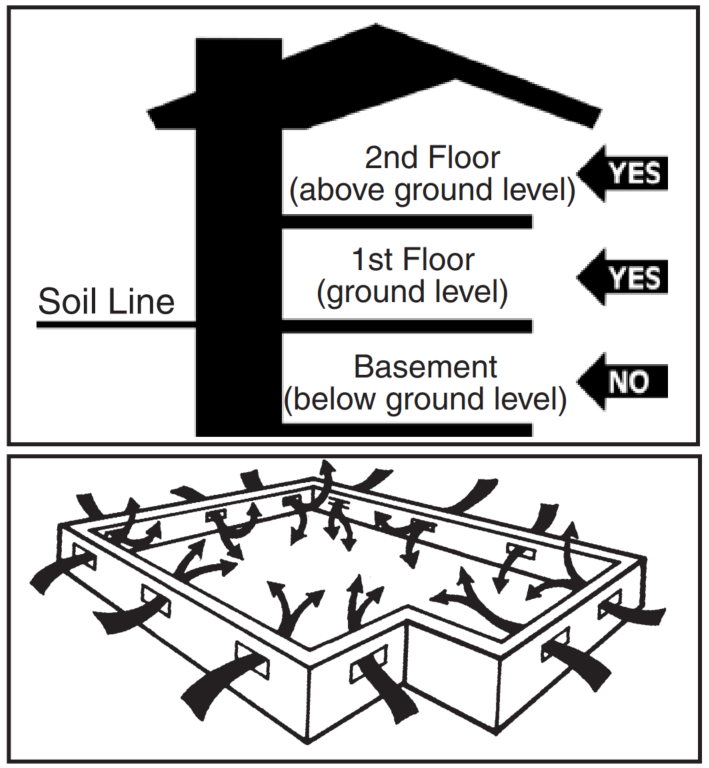
SUBFLOOR CONDITIONS
- CLEAN – Subfloor must be free of wax, paint, oil, sealers, adhesives and other debris.
- LEVEL/FLAT – Subfloor must be within 3/16” in 10’ (5 mm in 3 m) and/or 1/8” in 6’ (3 mm in 2 m). Sand high areas or joints. For best results, flatten low spots with a maximum 6 layers of 15# builders felt, plywood or shims (not leveling compounds).
- DRY – Check and document moisture content of the subfloor with the appropriate moisture test. Install moisture retardant materials if needed or desired. (See plank installation note in Section IV) In order to best prevent/reduce risk of moisture, moisture retardant materials must meet minimum perm standards of 3 > 50 ASTM D4869-88, Type I or F.S. UU-B-790a, Type I, Grade D, Style 1a. Most Asphalt saturated papers, 15# felt, 30# felt or Grade D kraft paper meet this perm rating. Install the vapor retarder over the wood subfloors prior to installing nail down flooring. Overlap the seams a minimum of 4 inches or more. (common brown kraft builder paper and red rosin generally do not qualify as vapor retarders). Concrete subfloors must be a minimum of 30 days old before testing begins.
- STRUCTURALLY SOUND – Any areas that are loose or squeak must be nailed or screwed. Wood panels should exhibit an adequate fastening pattern, glued/screwed or nailed as system requires, using an acceptable nailing pattern. Typical nailing: every 6˝ (15 cm) along bearing edges and every 12˝ (31 cm) along intermediate supports. Flatten any swollen edges as necessary. Replace any water-damaged, swollen or delaminated subflooring or underlayments.
NOTE: Subfloors with excessive vertical movement should be avoided. Optimum performance of hardwood floor covering products occurs when there is little horizontal or vertical movement of the subfloor. If the subfloor has excessive vertical movement (deflection) before installation of the flooring, it is likely it will do so after installation of the flooring is complete.
SUBFLOORS WITH RADIANT HEAT
DO NOT INSTALL THIS PRODUCT OVER SUBFLOORS WITH RADIANT HEAT.
TOOLS & ACCESSORIES NEEDED
IT IS EXTREMELY IMPORTANT TO USE THE PROPER ADAPTERS, FACE PLATES, AS WELL AS STAPLES OR CLEATS. USING IMPROPER FASTENERS, MACHINES AND/OR AIR PRESSURE CAN CAUSE SEVERE DAMAGE.
For All Installation Methods
- Chalk line & chalk
- Recommended hardwood flooring cleaner
- Tape measure
- Hammer
- Moisture meter (wood, concrete or both)
- Broom
- Hand saw or jamb saw
- Eye protection
- Transition and wall moldings
- Premium Urethane construction adhesive for floors 4″ (10 cm) or wider
- Refer to recommended products
For Mechanically Fastened Installations
- Nail set
- Electric power saw
- NIOSH-designated dust mask
- Electric drill and bits
- Compressor and hose w/in-line regulator for pneumatic tools
- “Blind’ fastening machine for 3/4˝ (19 mm) flooring (see note below)* w/1-1/2˝ or 2˝ (4-5 cm) fasteners
- Pneumatic finish nailer with 1-1/2˝ or 2˝ (4-5 cm) nails
- 6-8d finish nails
Use a “Blind” nailing machine designed for installing 3/4˝ (19 mm) hardwood flooring using staples or cleats. The nailing machine MUST HAVE a protective foot attachment to prevent edge bruising and finish damage.
*NOTE: The flooring manufacturer does not recommend nor endorse any specific brand or type of mechanical fastener

For Glue-Down Installations
- Recommended adhesive and adhesive remover
- 1/4˝ x 1/2˝ x 3/16˝ (6 mm x 13 mm x 8 mm) V-Notch trowel (Figure 2) or other adhesive manufacturer’s trowel
- Scotch® Delicate Surface Painter’s Tape 2080
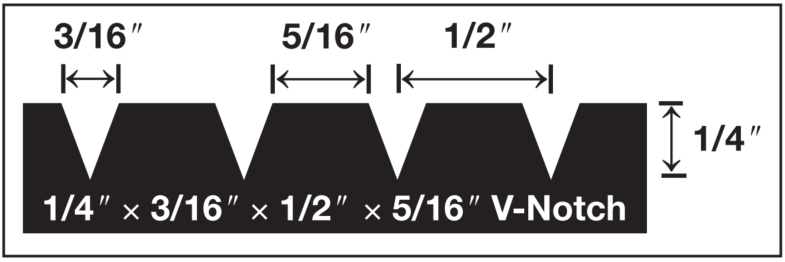
III. SUBFLOOR/UNDERLAYMENT
REQUIREMENTS
NOTE: Solid hardwood flooring can be fastened to most existing flooring materials providing they can be penetrated with the fastener and the subfloor/underlayment materials meet or exceed the recommended subfloor/underlayment requirements. Laminated rosin paper or 15# builders felt (tar paper) acts as a moisture retarder and may be used to reduce movement caused by changes in subfloor moisture, thereby reducing cupping and warping. (This is especially helpful over crawl spaces and basements.) In addition, the use of these materials can give the flooring a more solid feeling, reduce sound transfer, prevent noise caused by minor irregularities and debris, and make it easier to slide the hardwood together across the surface of the subfloor. Kraft paper may be used to make installation easier but DOES NOT serve any other purpose.
Wood Subfloors and Underlayment
General: The wood subflooring materials should not exceed 12% moisture content. Using a reliable wood moisture meter, measure the moisture content of both the subfloor and the hardwood flooring to determine proper moisture content. The difference between the moisture content of the wood subfloor and the hardwood flooring should not exceed 3% for strip and 2% for plank flooring. When installing parallel to the floor joists it may be necessary to stiffen the subfloor system by installing an additional minimum of 3/8˝ (9.5 mm) approved wood underlayment. Applicable standards and recommendations of the construction and materials industries must be met or exceeded.
NOTE: As a flooring manufacturer, we are unable to evaluate each engineered joist/subfloor system. Spacing and spans, as well as their engineering methods are the responsibility of the builder, engineer, architect or consumer who is better able to evaluate the expected result based on site-related conditions and performance. The general information provided below describes common, non-engineered joist/subfloor systems. Engineered flooring joist/ subfloor systems may allow for wider joist spacing and thinner subflooring materials.
Wood Structural Panel Subfloors and Underlayment
(Non-engineered)
To act as a moisture barrier, structural panels/underlayment must be installed sealed side down. When used as a subfloor, allow 1/8˝ (3 mm) expansion space between each panel. If spacing is inadequate, cut in with a circular saw. Do not cut in expansion space on tongue and groove panels.
- Plywood: Should be minimum CDX grade (exposure 1) and meet US Voluntary Product Standard PS1-95 performance standard or Canadian performance standard CAN/CSA 0325-0-92. The preferred thickness is 3/4˝ (19 mm) as a subfloor [minimum 5/8˝ (16 mm)]. When using an underlayment panel a minimum 3/8˝ (9.5 mm) thickness is recommended.
- Oriented Strand Board (OSB): Conforming to US Voluntary Product Standard PS2-92 or Canadian performance standard CAN/CSA 0325-0-92 construction sheathing. Check the underside of the panel for codes. When used as a subfloor, the panels must be tongue and groove, and installed sealed side down. Minimum thickness to be 23/32˝ (18 mm) thick when used as a subfloor or 3/8˝ (9.5 mm) as an underlayment. Some board manufacturers’ recommendations vary.
Solid Wood Subfloors
- Minimum 3/4˝ (19 mm) thick with a maximum width of 6˝ (15 cm) installed at a 45° angle to the floor joists.
- The subfloor must be Group 1 dense softwood (Pine, Larch, Douglas Fir etc) No. 2 common, kiln dried with all board ends bearing on joists.
Concrete
(Requires Additional Subfloor)
NOTE: The use of a plywood subfloor when installing solid hardwood flooring over a concrete slab is highly recommended. In a situation where you must direct glue to concrete, review the adhesive manufacturer’s recommendation for proper application, proper adhesive and correct trowel notch and spread rate, as well as their warranty coverage (some adhesive manufacturers have had substantial success with direct glue applications (no plywood subfloor) using a variety of different adhesives and moisture retardant systems).
Concrete Moisture Tests
All concrete subfloors should be tested, and results documented, for moisture content. Visual checks may not be reliable. Test several areas, especially near exterior walls and walls containing plumbing. Acceptable test methods for
subfloor moisture content include:
- Tramex Concrete Moisture Encounter Meter (Figure 3): Moisture readings should not exceed 4.5 on the upper scale. (Figure 3 shows an unacceptable reading of over 4.5) Concrete Moisture Meters give qualitative reading results-not quantitative ones. These results are a quick way to determine if further testing is required.
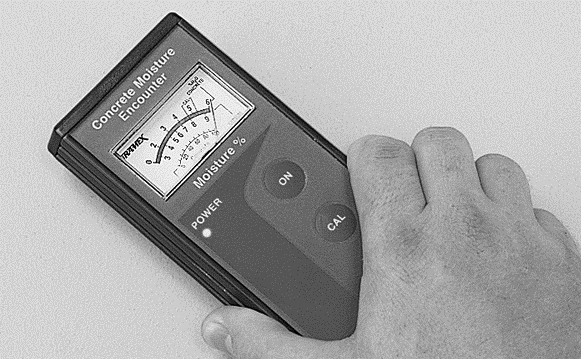
NOTE: To ensure appropriate moisture content, the following tests should be conducted in all residential/commercial applications. (Either or both tests is/are acceptable).
- Calcium Chloride Test (ASTM F 1869): The maximum moisture transfer must not exceed 3 lbs./1000 ft.2 in 24 hrs. With this test.
- RH Levels in Concrete Using In-situ Probes (ASTM F 2170) should not exceed 75%.
“DRY” CONCRETE, AS DEFINED BY THESE TESTS CAN BE WET AT OTHER TIMES OF THE YEAR. THESE TESTS DO NOT GUARANTEE A DRY SLAB.
Moisture Retardant System: If excessive moisture is present or anticipated, use a Moisture Retardant System. Bruce® Summit Select™ All In One Premium Adhesive may be used as a moisture retardant system to reduce vapor intrusion. Apply the adhesive using the recommended trowel or other adhesive manufacturer’s trowel. Flooring can be installed immediately after applying the adhesive. No moisture test is required.
Wood/Concrete Subfloor Systems
- Fastened to concrete: Install a suitable moisture retardant followed by a plywood subfloor with a minimum of 3/8˝ (9.5mm) [1/2˝ (13 mm) preferred]. Allow 1/2˝ (13 mm) expansion space around all vertical objects and 1/8˝ (3 mm) between all flooring panels. Install a second layer of plywood, the same thickness, at a right angle to the previous panels, offsetting the joints 2´ (61 cm). Staple together with staples that will not penetrate the first layer of the subfloor. The staples should have a crown width of 3/8˝ (9.5 mm) or more. Install a moisture retardant barrier with joints lapped 6˝ (15 cm) and begin installation of flooring using 1-1/2˝ (4 cm) fasteners.
- Screeds/sleepers: NOTE: Solid hardwood flooring 4˝ (10 cm) or more in width cannot be installed directly to screeds. Screeds should be installed 9˝ (23 cm) apart, in rivers of adhesive, at right angles to the flooring to be installed. Do not begin installation until all adhesives are properly cured. Install moisture retardant over the screeds prior to installation of the flooring.
IV. INSTALLING THE FLOOR
General Installation Tips
- Install the moisture retardant (if used) parallel to the flooring. Overlap the rows 6˝ (15 cm). Overlap (top) should be on the same side as the groove of the flooring so that the hardwood will slide smoothly into place. Staple the moisture retardant material as necessary to prevent excessive movement.
- Use pieces of flooring from several different cartons at the same time to ensure good color and shade mixture and variation.
- When possible, preselect and set aside boards that blend best with all floor mounted moldings to ensure a uniform final appearance. Install these boards adjoining the moldings.
- Be attentive to staggering the ends of boards at least 4˝-6˝ (10-15 cm), when possible, in adjacent rows (Figure 4). This staggering pattern will help ensure a more favorable overall appearance of the floor.
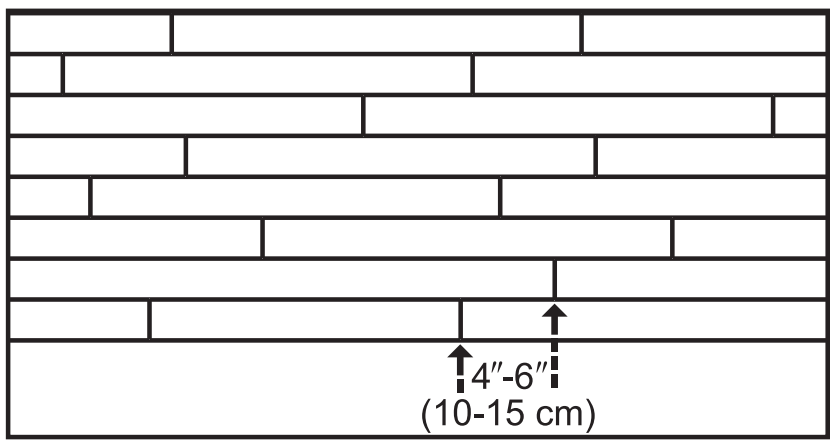
Preferred Alignment
- When installing products of uniform length, begin the rows with starter boards cut to various lengths. Avoid staggering the rows uniformly to prevent stair-stepping. Boards cut from the opposite end of the row may be used for the next starter boards.
- Large spans exceeding 20´ (6 m) in hardwood flooring width, in areas of high humidity, may require the addition of internal or field expansion. This expansion can be accomplished by using spacers, such as small washers, every 10-20 rows inserted above the tongue. Remove the spacers after several adjoining rows have been fastened. Do not leave spacers in for more than two hours.
- Always allow a minimum 3/4˝ (19 mm) expansion around all vertical obstructions.
- Always use a protective foot on the fastening machine to prevent mallet damage and edge bruising.
General Information for “Blind Fastening” Machines
- Avoid striking the edge of prefinished products with the fastener’s mallet, as edge crushing can occur, causing unsightly cracks and splinters. Use a protective foot attachment to prevent edge bruising and finish damage.
- Improper adapter plates and air pressure settings can cause severe damage to the hardwood flooring and reduce performance (Figure 5). Always use an in-line regulator to control air pressure to the machine. Set pressure at 70-75 PSI to begin with and adjust until proper fastener setting occurs.
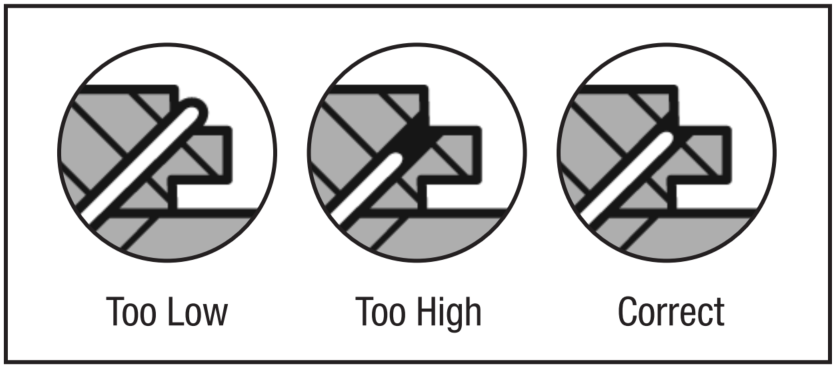
NOTE: SPECIAL INSTRUCTIONS FOR PLANK FLOORING
Seasonal distortion (shrinkage/cupping) in wide width flooring (4˝ (10 cm) and over) may be reduced by gluing the flooring to the subfloor, in addition to the use of mechanical fasteners. Reminder: adhesives used for this purpose will not perform their function when used in conjunction with a moisture retardant. Glue assisted applications will not be satisfactory without direct contact with the subfloor. The glue should be a premium grade urethane construction adhesive applied in a serpentine pattern to the back of the hardwood plank in a 1/4˝ bead as noted in Figure 6
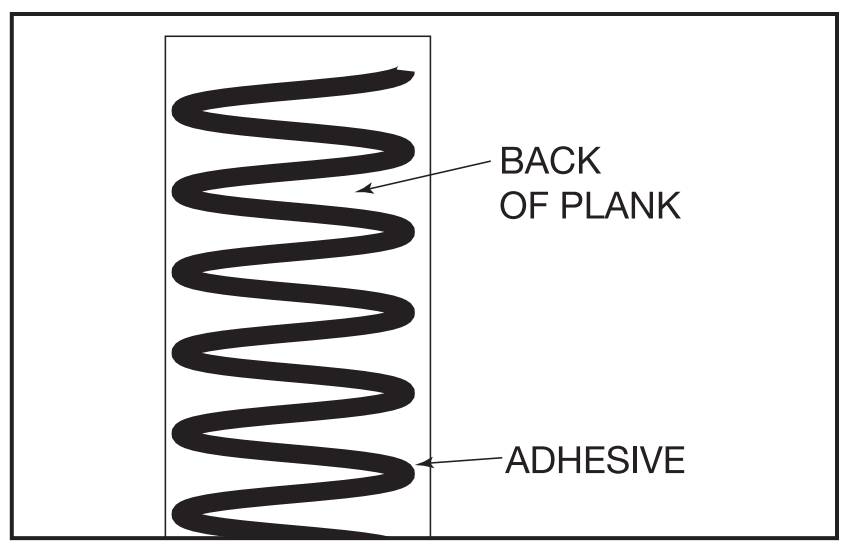
STEP 1: Doorway and Wall Preparation
(All Installations)
- Undercut door casings and jambs. Remove any existing base, shoe mold or doorway thresholds. These items can be replaced after installation. All door casings and jambs should be undercut to avoid difficult scribe cuts (Figure 7).
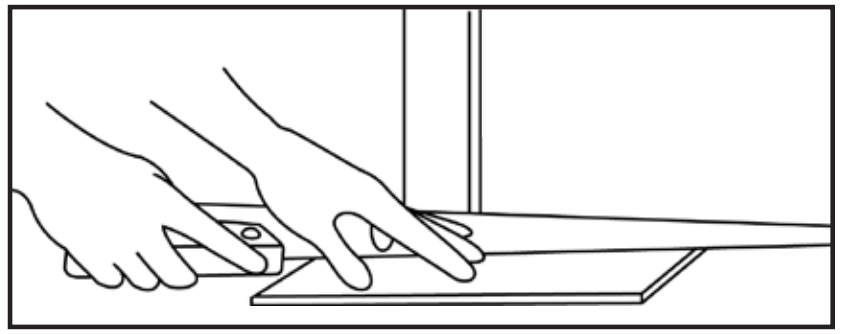
STEP 2: Establish a Starting Point
(All Installations)
- For best visual results, install flooring parallel to the longest wall; however, the floor should always be installed perpendicular to the flooring joists unless subfloor has been reinforced to reduce subfloor sagging.
- When possible, begin layout or installation from the straightest wall (generally an outside wall).
- In at least two places at least 18˝ (46 cm) from the corner, measure out equal distance from the starting wall (Figure 8) the face width of the starter board plus 1˝ (2.5 cm) (do not include the width of the tongue in this measurement). Mark these points and snap a chalk line through them. This measurement allows for the required 3/4˝ (19 mm) expansion and the width of the tongue.
- In at least two places at least 18˝ (46 cm) from the corner, measure out equal distance from the starting wall (Figure 8) the face width of the starter board plus 1˝ (2.5 cm) (do not include the width of the tongue in this measurement). Mark these points and snap a chalk line through them. This measurement allows for the required 3/4˝ (19 mm) expansion and the width of the tongue.
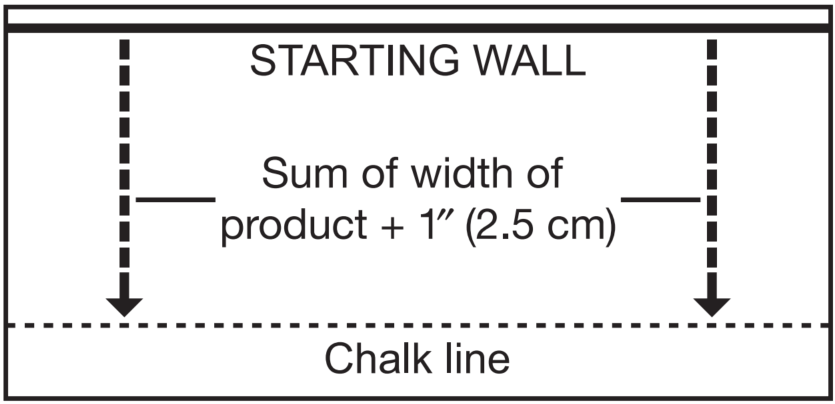
STEP 3: Installing First & Second Rows – Starting from Wall
(Mechanically Fastened/Staple-Down Installations)
- Use the longest, straightest boards available for the first two rows. For random and alternate width products, use the widest plank for the first row. Align tongue of first row on chalk line. The groove should be facing the starting wall.
- Use a pneumatic finish nailer to face-nail the groove side 1/2˝ (13 mm) from the edge at 6˝ (15 cm) intervals and 1˝-3˝ (2.5-7.6 cm) from each end. Then, blind nail using a finishing gun held at a 45° angle. Nail down through the nailing “pocket” on top of the tongue every 6˝-8˝ (15-20 cm) (Figure 9).
- If using finish nails, pre-drill the nail holes with a 1/32˝ (1.7 mm) bit approximately 1/2˝ (12.7 mm) from back (groove) edge, 1˝-3˝ (2.5-7.6 cm) from each end, and at 6˝ (15 cm) intervals. Pre-drill at the same intervals at a 45° angle down through the nailing “pocket” on top of the tongue (Figure 9). Face-nail the groove side where pre-drilled. When complete, blind-nail at a 45° angle through the tongue of the first row. Fasten using 6 or 8d finish nails. Countersink nails to ensure flush engagement of the groove. Avoid bruising the hardwood by using a nail set to countersink the nails.
- Continue blind-nailing using this method with the following rows until blind nailer can be used.
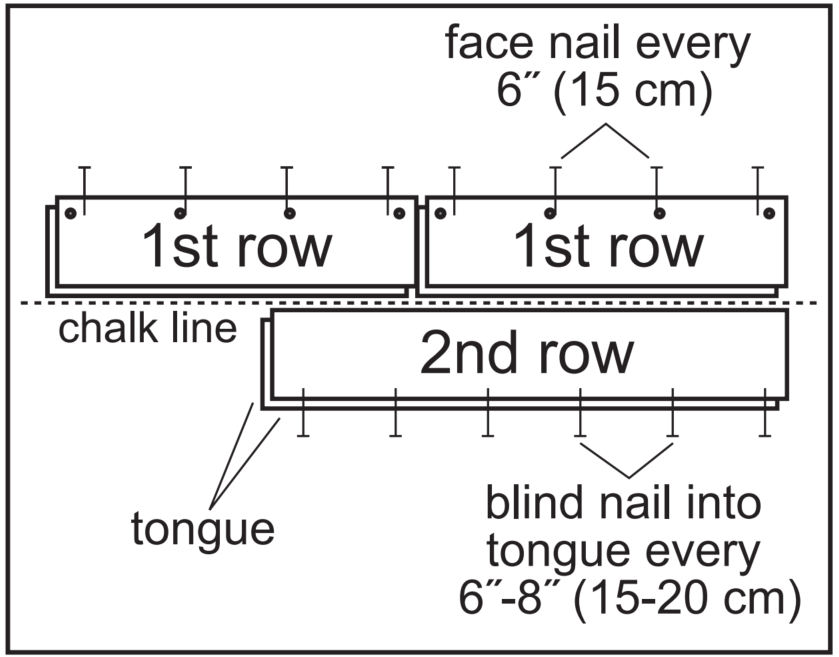
STEP 2- 3 Alternative: Installing First & Second Rows – Starting from Center of Room
(Mechanically Fastened/Staple-Down Installations)
- Snap a chalk line down the center of the room.
- Install a “sacrificial row” that extends the entire length of the room on the centerline.
- Install three rows of flooring.
- Remove the sacrificial row and insert wood glue in the groove followed by a slip tongue (spline) in the exposed groove. Always glue and nail the slip tongue in place. Installation can now continue from the center in both directions.
- NOTE: Do not reuse/reinstall the boards from the sacrificial row.
STEP 4: Dry Lay (Racking) the Floor
- “Dry” lay (rack) materials to cover approximately 2/3 of the room. Begin dry laying (racking) approximately 6˝ (15 cm) from the edge of the previously installed rows. Avoid pulling boards too tightly together on the sides, as they must move freely when fastening begins.
- Do not cut final board until row has been installed. Cutting the board in advance may result in a board that is too short.
- Visually inspect flooring, setting aside boards that need to have natural character flaws cut out. Use these boards for the starting and finishing rows only after objectionable characteristics have been removed.
STEP 5: Installing the Floor
- Use the blind nailer to fasten a sacrificial board to the floor. Check for surface damage, air pressure setting, tongue damage, before proceeding. Make all adjustments and corrections before installation begins. Once proper adjustments have been made, remove and destroy the board.
- Begin installation with several rows at a time. Use the fastener schedule (Figure 10) for proper spacing based on board width. Fasten each board with a minimum of two fasteners 1˝-3˝ (2.5-7.6 cm) from the ends. To ensure a more favorable overall appearance, end-joints of adjacent rows should be staggered a minimum of 4˝-6˝ (10-15 cm) when possible.
- The last 1-2 rows will need to be face-nailed where clearance does not permit blind nailing with the stapler or brad nailer. Pre-drill and face-nail on the tongue side following the nailing pattern used for the first row.
- Rip final row to fit and face-nail. If the final row is less than 1˝ (2.5 cm) in width, it should first be glued to the previous UNINSTALLED row and the two joined units should be face nailed as one.
Fastener Schedule
| Width of flooring | 1-1/2″ to 3-1/2″ (4-9 cm) | 4″ (10 cm) and over |
| Maximum spacing | 10″ – 12″ (25 – 30 cm) | 8″ – 10″ (20 – 25 cm) |
| Preferred spacing | 8″ – 10″ (20 – 25 cm) | 6″ – 8″ (15 – 20 cm) |
General Information for Glue-Down Applications
| Adhesive | Working Time |
| Bruce® Summit Select Unlimited Moisture Vapor Barrier Elastomeric Wood Flooring Adhesive | 45 Minutes |
- Open times and curing times of ALL adhesives vary depending upon subfloor porosity, air movement, humidity and room temperature. Adjust the amount of adhesive spread on the subfloor accordingly. The adhesive should not be applied if subfloor or room temperature is below 60°F (16°C). WORKING TIME WILL VARY DEPENDING ON JOB SITE CONDITIONS.
- Hold trowel at a 45° angle (Figure 11) firmly against the subfloor to obtain a 50-60 ft.2 (4-5.5 m2) per gallon spread rate (30-35 ft.2 per gallon for Summit spread with the recommended trowel size) or other adhesive manufacturer’s trowel. The trowel will leave ridges of adhesive and very little adhesive between the ridges. This method will allow you to still see the chalk lines between the ridges and provide the recommended spread rate. For additional application instructions, follow the recommendations on the adhesive container.
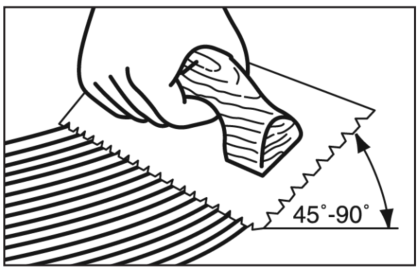
- An anchor row may be set and secured to the subfloor to provide a stationary point to be pushed against so flooring does not move during the installation.
- Ensure proper ventilation within the room to mitigate fumes. An electric fan is helpful.
- Rolling is not required with the Summit Select All in One adhesive, but if desired, do not do so until the adhesive has cured for 2 hours. When using the Bruce Summit Select Unlimited Moisture Vapor Barrier Elastomeric Wood Flooring adhesive, roll and cross roll floor with a 75-100 lbs (34-45 kg) roller within 1 hour of installation and again within 2 hours to ensure proper transfer of adhesive.
NOTE: DO NOT INSTALL FLOORING USING RUBBER MALLETS. STRIKING THE SURFACE WITH A RUBBER MALLET MAY “BURN” THE FINISH CAUSING IRREPAIRABLE DAMAGE.
STEP 3: Spread the Adhesive
(Glue-Down Installations)
- Spread sufficient amounts of the recommended adhesive with the recommended trowel (Figure 2) in an area that can be covered in 60 minutes (see adhesive information).
- If necessary, nail a sacrificial row with 1˝ (2.5 cm) nails on the dry side of the chalk line to help hold the first row in place.
NOTE: Avoid kneeling or installing on the surface of the flooring. If necessary, distribute weight using a kneeler board.
STEP 4: Installing the Floor
(Glue-Down Installations)
(Figure 12a-12d)
- Use the longest, straightest boards available for the first 2 rows. For random and alternate width products, use the widest plank for the first row. The first row of planks should be installed with the edge of the groove lined up on the chalk line. The tongue should be facing the starting wall. The first row must be aligned and seated in the adhesive, as all additional rows will be pushed back to this original row. Remove tongue to allow for expansion space, if necessary, on the row adjoining the wall.
- When installing pieces, engage the end-joint first, as close to the side (long) tongue and groove as possible, then slide together tightly to engage the side (long) joint tongue and groove. To avoid adhesive bleed-through and memory pull-back, avoid (as much as possible) sliding pieces through the adhesive when placing them into position
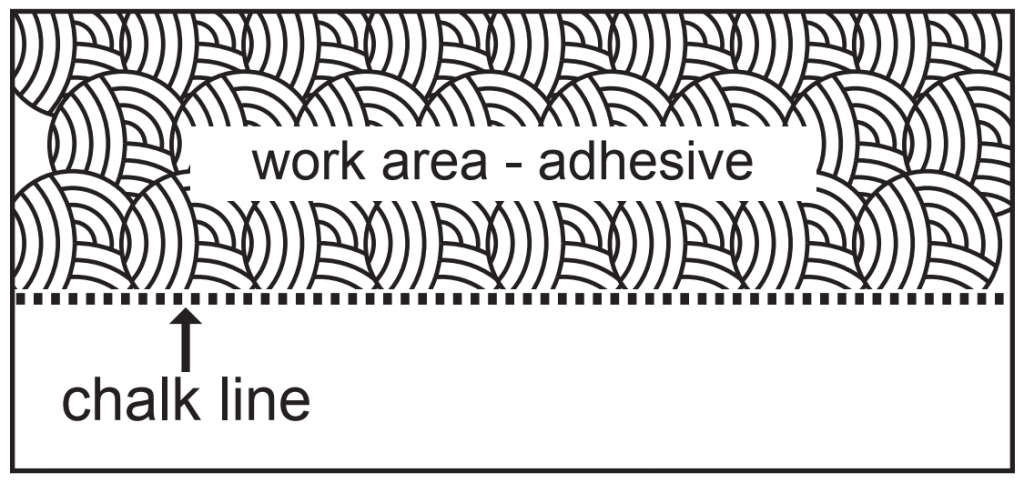
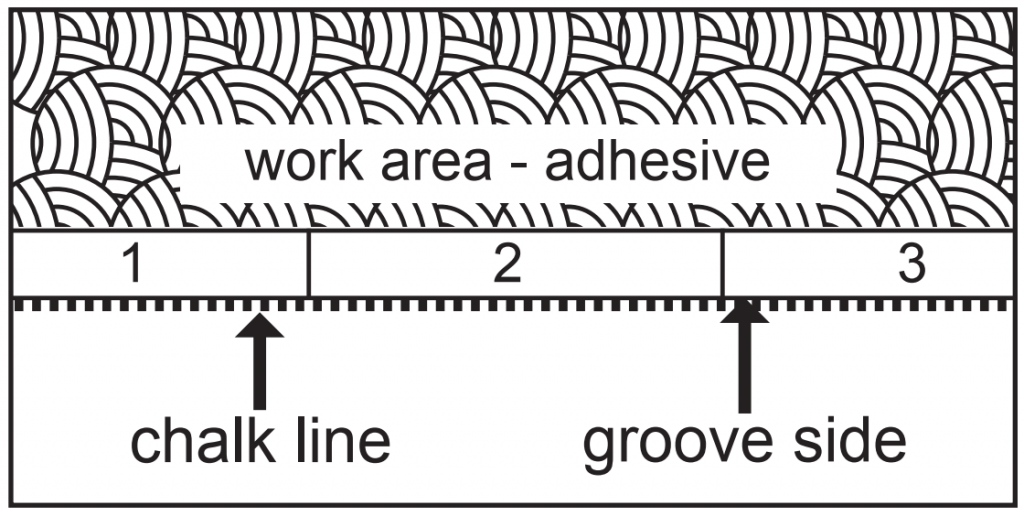
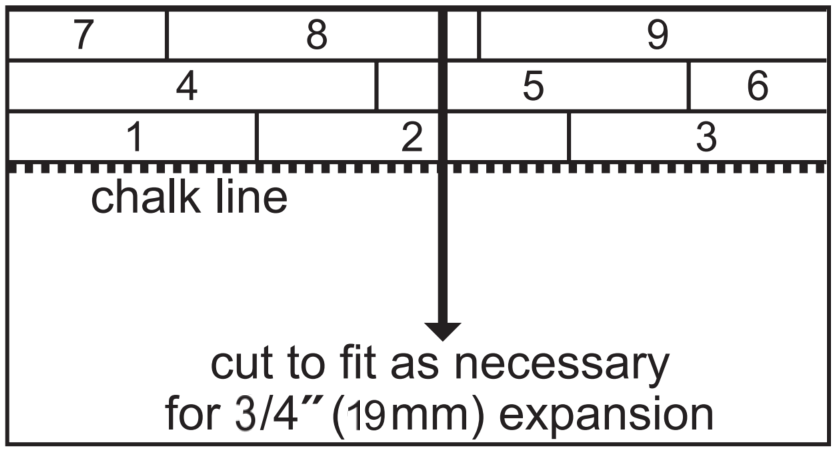
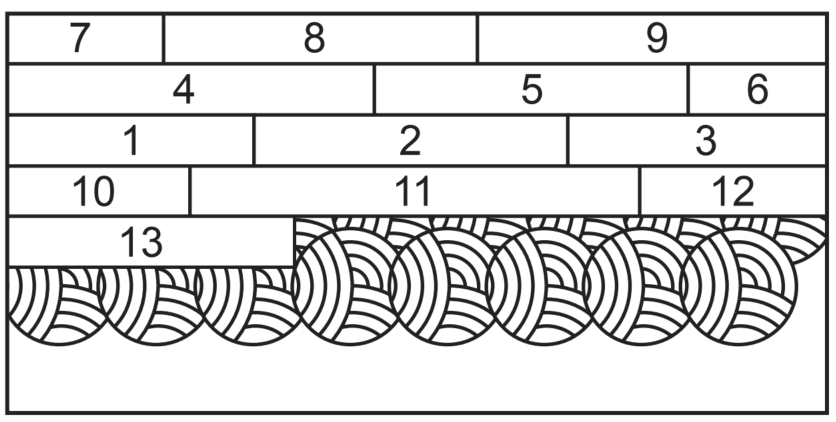
STEP 5: Installing the Floor
(Glue-Down Installations)
- During the installation occasionally remove a piece of flooring from the subfloor and inspect the back for proper adhesive transfer. Adequate adhesive transfer is necessary to ensure sufficient holding strength.
- If the adhesive skins over and fails to transfer, remove and spread new adhesive to achieve proper bonding.
- The last 1-2 rows will need to be face-nailed when clearance does not permit blind nailing with a stapler or a brad nailer. Pre-drill and face-nail or pneumatically nail on the groove side, following the nailing pattern used for the first row.
NOTE: Clean adhesive from the surface of the floor frequently, using the recommended adhesive cleaner. Do not use Scotch® Delicate Surface Painter’s Tape 2080 before adhesive is removed from the surface. Use clean towels, changed frequently, to prevent haze and adhesive residue.
- Check for a tight fit between all edges and ends of each plank. End joints of adjacent rows should be staggered 4˝-6˝ (10-15 cm) when possible, to ensure a more favorable overall appearance (Figure 4).
- It may be necessary to align the product with a cut-off piece of scrap as shown in (Figure 13 – Keep scrap angle low to avoid edge damage).
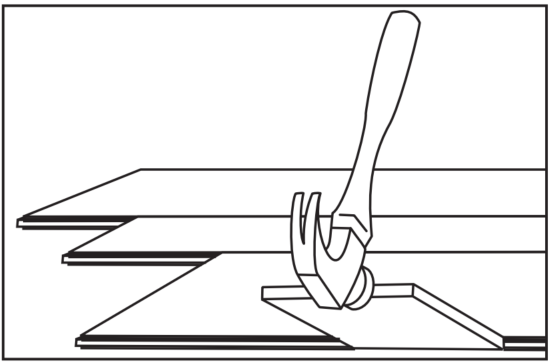
- To eliminate minor shifting or gapping of product during installation, use Scotch® Delicate Surface Painter’s Tape 2080 to hold the planks together. After installation is complete, remove all of the Scotch® Delicate Surface Painter’s Tape 2080 from the surface of the newly installed flooring. Do not let the tape remain on the flooring longer than 24 hours. Avoid the use of masking or duct tape, which leaves an adhesive residue and may damage the finish.
- If necessary, use weights to flatten boards with bows until adhesive cures, in order to prevent hollow spots. Boards that cannot be flattened should be cut in length to reduce the bow or should be not used.
- Be sure not to spread adhesive too far ahead of your work area (Figure 12d).
- Complete the installation using this same technique for the remainder of the floor.
- Avoid heavy foot traffic on the floor for at least 24 hours. Lift the furniture or fixtures back into place after 24 hours
STEP 6: Complete the Installation
- Remove all tape and clean the floor with the recommended hardwood flooring cleaner.
- Install or re-install any transition pieces, reducer strips, T-moldings, thresholds, bases and/or quarter round moldings that may be needed. These products are available pre-finished to blend with your flooring (see below). Nail moldings into the wall, not the floor.
- Inspect the floor, filling all minor gaps with the appropriate blended filler.
- If the floor is to be covered, use a breathable material such as cardboard. Do not cover with plastic.
- Installers (that are not owners) should leave warranty and floor care information with the owner and advise them of the product name and code number of the flooring they purchased.
- To prevent surface damage, avoid rolling heavy furniture and appliances on the floor; use plywood, hardboard or appliance lifts if necessary. Use protective castors/castor cups or felt pads on the legs of furniture to prevent damage to the flooring.
V. TRANSITION AND WALL MOLDINGS

- Reducer Strip: A teardrop shaped molding used around fireplaces, doorways, as a room divider, or as a transition between hardwood flooring and adjacent thinner floor coverings. Fasten down with adhesive, small nails or double faced tape.
- Threshold: A molding undercut for use against sliding door tracks, fireplaces, carpet, ceramic tile, or existing thresholds to allow for expansion space and to provide a smooth transition in height difference. Fasten to subfloor with adhesive and/or nails through the heel. Predrill nail holes to prevent splitting.
- Stair Nosing: A molding undercut for use as a stair landings trim, elevated floor perimeters, and stair steps. Fasten down firmly with adhesive and nails or screws. Predrill nail holes to prevent splitting.
- Quarter Round: A molding used to cover expansion space next to baseboards, case goods, and stair steps. Predrill and nail to the vertical surface, not into the floor.
- Combination Base and Shoe: A molding used when a base is desired. Used to cover expansion space between the floor and the wall. Predrill and nail into the wall, not the floor.
- T-Molding: A molding used as a transition piece from one rigid flooring to another of similar height or to gain expansion spaces. Fasten at the heel in the center of the molding. Additional rigid support may need to be added to the heel of the molding dependent upon the thickness of the goods covered. Do not use this molding as a transition to carpet.
INSTALLERS – ADVISE YOUR CUSTOMER OF THE FOLLOWING
FLOORING OWNERS – BE ADVISED OF THE FOLLOWING
Seasons: Heating and Non-heating
Recognizing that hardwood floor dimensions will be slightly affected by varying levels of humidity within your building, care should be taken to control humidity levels within the 30-50% range. To protect your investment and to assure that your floors provide lasting satisfaction, we have provided our recommendations below.
- Heating Season (Dry): A humidifier is recommended to prevent excessive shrinkage in hardwood floors due to low humidity levels. Wood stoves and electric heat tend to create very dry conditions.
- Non-Heating Season (Humid, Wet): Proper humidity levels can be maintained by use of an air conditioner, dehumidifier, or by turning on your heating system periodically during the summer months. Avoid excessive exposure to water from tracking during periods of inclement weather. Do not obstruct in any way the expansion joint around the perimeter of your floor.
- Damage caused by failing to maintain the proper humidity levels is not manufacturing related and will void the floor’s warranty.
NOTE: Final inspection by the end-user should occur from a standing position.
FLOOR REPAIR
Minor damage can be repaired with a Bruce touch-up kit. Major damage will require board replacement, which can be done by a professional floor installer.
